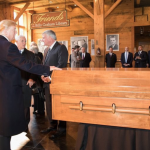In a recent Guardian article, Christina Rees offers her own diagnosis and prescription for how to revitalize the Church of England.
As an Anglican priest and a British expat living down-under, I can relate to the issues that Rees raises because we face many of the exact same issues in Australia.
I think Rees also points out a problem with an ecclesial system centred on the local parish. The reality is that the village church or suburban church was a great thing, it created community, because you had high street shopping and high church liturgy all within walking distance.
However, the reality is that cars and the internet are maybe not killing, but undermining the parish system. People would rather drive 20 minutes to a church that they like than walk to their local parish. Concurrently, the internet has created as a smorgasbord of on-demand sermons, videos, podcasts, social media, and on-line communities that have come to substitute for the parish community. In addition, some multi-site churches equipped with pastors, musicians, and techies are now practical dioceses within themselves. In response, proposed initiatives based on increased community involvement and alternative models of church are certainly one way of addressing this issue if we want to avoid English Anglicanism becoming reduced to twenty or so mega-parish networks, thirty or so cathedrals, a smattering of small niche churches for people united by their disgruntledness on women bishops or LGBTI inclusion, and a strange array of e-churches.
But I found Rees’s suggestion to be very lacking:
If the church wants to survive, and thrive, it will need to see itself in a new light – more responsive, and willing to embrace how people live today. Most people, especially young people, don’t want to have to step through the doorway of a church to engage with the big issues of life. They don’t want to sit in pews on Sunday mornings to listen to a sermon or a set, age-old liturgy. They want to know how to navigate the complexities of their lives and how to address their deepest longings, doubts and fears. And they want to feel safe. So the whole church will have to become much more interactive and flexible. The pattern for the future may well look a lot more like the early church, with small groups meeting in each other’s homes.
I can affirm Rees’s quest for holism, her attempt to balance evangelism and justice, and holding forth an integrated theological, social, and ethical praxis. But there’s a downside.
First, her prescription sounds a lot like group therapy for young people combined with hardcore #wokeism. Nothing Rees suggested needs the Christian message or even Christian people. I reckon you could get everything she proposes with a comfy couch, a couple of friends, a blanket, Netflix, retweeting Guardian articles, and a bag of crisps.
Second, Rees promotes consumerism as the answer to a caricature. Rees imagines that young people don’t want to endure having to actively listen to someone, they don’t want to have to sit down on something hard, or pay attention to anything that’s not on their iPhone. Rees implies that if you are not talking about young people then they are incapable of listening. Rees supposes that without spatial luxury, without something entertaining for their short attention spans, and without something therapeutic for their tender egos, that young people will simply abandon church and resume their quest for a narcissist nirvana. I know some young people who are like that, but I also know a great many who do not fit this caricature. So I would counsel that therapeutic moral deism, gourmet coffee, talking about feelings, and sitting on fluffy pillows is not a solution because, just maybe, not all young people are quite so consumerist and self-absorbed as Rees alleges.
Third, Rees is in favour of small groups meeting in people’s homes. Well, the house church movement has been around since the 1960s, it got a shot in the arm with the emergent experiments of the 90s and 00s, and it has been effective in places like China. But house churches have never really become a serious competitor to the parish system in the UK, Australia, or America. Maybe that will change, maybe house churches will supersede the parish system, or more likely, the parishes that thrive will be those with a robust network of house groups.
Fourth, notice words that Rees didn’t use in her article: “worship,” “Jesus,” “Scripture,” and “discipleship.” In a frankly bizarre and stunning omission, she left out everything that constitutes the marks of a true church and what actually are the best things about church! The magnetic power of Jesus, the mystery of the sacraments, joining something ancient, the joy of worship, hearing God’s word preached with passion, rejoicing and lament, discipleship, mentoring, sharing in life together, a global communion, baptisms-marriages-funerals, and mission.
I would urge people to read Rees article, and then to go to the other extreme and read or watch Pope Pius XIII’s speech to the cardinals in the Sistine Chapel (from HBO’s The Young Pope). It is quite a speech!
Brother cardinals, we need to go back to being prohibited, inaccessible and mysterious. That’s the only way we can once again become desirable. That is the only way great loves stories are born. And I don’t want any more part-time believers. I want great love stories. I want fanatics for God. Because fanaticism is love.
I don’t go for either Rees or Pius XIII’s plan for the church, but if push comes to shove, I’m more inclined towards Pius. Forget pandering to millennials, let’s be mysterious, alien, passionate, and (in the best sense) fanatical.
Photo: Wikimedia commons.












